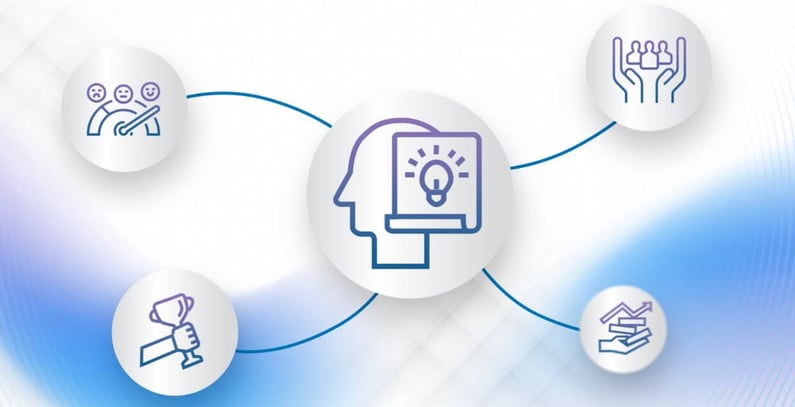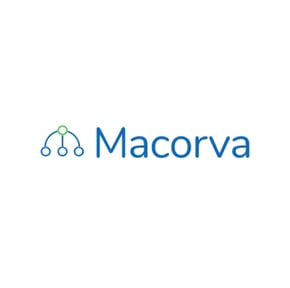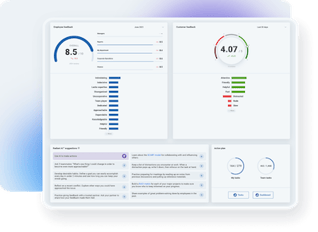
How to Write a Good Employee Performance Review: Tips, Strategies, and Examples
Seeking to capitalize on this trend, leading businesses now look for ways to use performance reviews to recognize achievements, motivate engagement, and encourage career advancement. In this article, we explore the purpose of modern performance reviews, how to write a performance review, and performance review examples that demonstrate how a meaningful dialogue between managers and employees can increase morale, productivity, engagement, and retention in the modern workplace.

Preparing for the Review
Preparation is key to a successful performance review and should include an examination of employee data from multiple sources. These can include:
- Achievements and contributions
- Feedback from peers and clients
- Talent review ratings
- Past review documents
- Manager notes
Automated performance review platforms collate employee data from multiple sources to give managers an updated, streamlined reference for the employee’s history, ratings, goals, and more. By automating preparation, managers can spend as much as 50% less time on administrative tasks, saving their resources for valuable in-person time with employees.
Structuring the Review
Once preparation is complete, managers need to know how to write a performance review, including how to create a review structure that emphasizes “developmental goals,” which the Harvard Business Review described as the future of performance assessments. Top-performing businesses are demonstrating that “accountability” is no longer as important as recognition and engagement when conducting an employee evaluation.
Therefore, a well-structured modern review includes the following components to ensure that the manager addresses the employee’s engagement, as well as their performance. We included key phrases in each section as starting points to inspire you when writing your own employee performance reviews.
Introduction
Psychology research shows that the ratio between positive and negative interactions in business should be 5:1 to maximize performance. This means that an employee evaluation should begin by setting a positive tone, such as by acknowledging the employee’s efforts, recognizing specific contributions, or positively assessing their value to their team or organization.
Specifically recognizing individual contributions is key to using positivity to improve performance by strengthening the connection between employees and their work culture. The introduction to a performance assessment is a great opportunity for managers to begin building this connection.
| Example phrase: “You have continued to demonstrate an ability to learn quickly and work well with your team. If you keep going in this direction, you will be on track for a leadership role.” |
Performance Assessment
Whether speaking about an employee’s strengths, shortcomings, or goals, refer to specific criteria from recent work to clarify your main objective. Employees should leave a performance assessment feeling more connected to their organization and more aware of what their next steps should be to improve. Use clear and objective language, and provide examples to support your assessment.
| Example phrase: "This year, your dedication and hard work have significantly contributed to the team's success, particularly in the ABC project." |
Strengths
Begin by highlighting the employee’s strengths to focus the assessment on positive encouragement. Use specific examples of recent instances where the employee excelled, either as an individual or as part of a team.
| Example phrase: "Your ability to manage multiple projects efficiently has been a key asset. For instance, handling the ABC project alongside your regular duties without missing deadlines was impressive." |
Areas for Improvement
Modern employees value upskilling in their jobs and advancing their careers, with a majority reporting a lack of upskilling opportunities as a “primary driver of quitting.” While recognition is effective at improving morale, constructive feedback transforms performance assessments into productive ongoing dialogues between employees and managers.
McKinsey research demonstrated that a lack of “opportunities to learn new things” was a primary cause of low employee retention rates in leading businesses. Highlighting areas of improvement in employee performance reviews presents healthy challenges to employees, which can lead to new skill acquisition and increased engagement.
| Example phrase: "While your project management skills are strong, there's room to improve in client communication. Being more proactive in updating clients about project progress could enhance client satisfaction and put you on the right track for advancement." |
Goals and Objectives
An increase in remote work opportunities has led to reduced clarity of work expectations, especially for new employees. To respond to these changes in worker needs, managers should focus performance assessments on measurable goals for each employee.
Discuss how these goals align with the individual’s career objectives as well as the team’s and organization’s broader goals. It is vital to regularly check in with employees, especially if they work in a remote or hybrid model, to ensure that their work lines up with the company’s mission.
Automated performance management tools allow managers to accurately track each employee’s career progress to personalize their assessments for their career goals.
| Example phrase: "To support your development in client communication, we'll arrange a workshop on effective communication strategies and assign you a mentor from the client relations team." |
Development Plan
Modern employees value the ability to upskill and develop in their careers, with 48% reporting in a Gallup-Amazon poll that they would switch companies to pursue skills training opportunities. Use this fact to your advantage by outlining each employee’s development plan during their performance assessment to help them grow. Outline training, mentoring, and project opportunities to provide a clear direction for them between now and the next assessment.
| Example phrase: "To support your development in client communication, we'll arrange a workshop on effective communication strategies and assign you a mentor from the client relations team." |
Closing
Keep the 5:1 positivity ratio in mind and end the performance review on a positive note. Encourage open communication about the employee’s experiences, misgivings, and opportunities while expressing confidence in their ability to grow and succeed in their position.
| Example phrase: "I'm confident that with focus and effort, you'll continue to grow and achieve great results. I'm here to support you in reaching these goals." |

Key Elements of Good Employee Performance Review
Here are ten key elements of good employee performance reviews, which help them assess employee strengths and shortcomings, recognize individual contributions, set a tangible developmental plan, and engage the employee in the company’s objectives.
1. Preparation and Documentation
Good performance reviews collect relevant data on the employee’s past performance, including their achievements, documented challenges, past performance reviews, and peer feedback. Focus on measurable data outcomes to communicate a clear picture of the employee’s performance improvement and present a tangible goal for them to work toward.
2. Frequent Review Cycles
Performance reviews that frequently recognize recent work show greater returns on engagement than those that rely on annual review cycles. Quarterly, monthly, or weekly feedback allows managers to recognize achievements and address performance gaps when the information is most relevant to the employee.
3. Two-Way Conversations
An effective employee evaluation begins as a productive dialogue between a worker expressing their experiences and a manager expressing interest in those experiences. As employees feel valued and heard, they are more likely to emotionally invest in their company’s objectives, especially as they relate to their career development. Managers in today’s leading businesses are phasing out the critical monologues of past evaluations and refocusing on two-way conversations to encourage honesty, trust, and tangible career development.
4. Clear and Objective Feedback
Clear and objective feedback is balanced between positive reinforcement and constructive criticism. Employees crave honest feedback as they hope to develop their skills and advance their careers based on their manager’s performance reviews. This implies the need to acknowledge performance gaps, but employee evaluations should never focus on negatives to the point that they become demoralizing.
Put another way, critical feedback should never feel “negative.” Consider this example of negative vs constructive performance feedback:
Negative: “In the last project, your poor performance cost the company thousands in schedule delays. You clearly weren’t ready for so much responsibility.”
Constructive: “We could tell that you struggled with aspects of your previous team project, and we want to help you improve them for next time. What do you think would have helped the project go more smoothly?”
By turning potentially negative criticism into a dialogue, managers can demonstrate that they value an employee’s perspective while offering productive suggestions for improving performance.
5. Goal Setting and Development Plans
When setting goals and career development plans with employees, managers should follow the SMART method, which means setting goals that are Specific, Measurable, Attainable, Relevant, and Time-based.
This should be a collaborative effort with the employee that builds on an established dialogue to set clear, tangible goals. These goals should include the employee’s growth, including training and mentoring opportunities as well as upcoming projects that showcase their new skills.
6. Recognition and Rewards
According to recent data, fewer than 1 in 4 employees strongly agree that they get sufficient recognition for their work. Employee performance reviews give managers the opportunity to acknowledge and reward an employee’s accomplishments to boost their morale and motivation.
While balancing recognition with areas for improvement, managers should remain focused on casting the employee’s career in a positive light, implying advancement and upskilling opportunities. Use the employee’s recent achievements as a starting point to make them feel appreciated by their leaders.
7. Continuous Feedback and Follow-Up
In addition to maintaining frequent review cycles, managers should foster a culture of continuous feedback outside the formal review periods to keep employees on track with their development and engaged with the company’s objectives.
Workplaces that maintain cultures of continuous learning reap the benefits of peer-to-peer knowledge-sharing while tracking and recording employee progress. Use follow-up meetings to review your employees’ developmental goals. Look for opportunities to provide additional support as needed.
8. Use of Performance Management Tools
Utilize performance management tools to streamline the review process, track performance data, and facilitate effective conversations with employees. With AI-enabled systems, managers can provide unbiased performance evaluations based on multiple data sources. This gives review conversations a clear, focused objective based on informed assessments.
Management tools also eliminate manager bias to help employees trust their evaluations. While personalized career development plans for each employee’s evaluation would normally require considerable administrative manpower, automated performance management tools assemble the data ahead of time, allowing managers to focus their attention on the employee.
9. Avoiding Common Pitfalls
Managers must be aware of common pitfalls in the employee review process, which can reduce engagement or lead to HR conflict if left unaddressed.
Feedback bias is one of the most potentially damaging since it impacts the trust that employees have in their performance reviews moving forward. Managers must take care to ensure fair and accurate evaluations that are free from common biases such as recency bias and confirmation bias.
For example, a performance review that falls victim to recency bias may overemphasize an employee’s recent mistakes and undervalue their past achievements. Confirmation bias means overemphasizing evidence that supports the manager’s preconception of an employee’s performance.
There are dozens of potential biases, including the halo/horns effect, similarity bias, contrast effect, gender bias, affinity bias, and more. Constructive language that emphasizes the employee’s path to improvement is a shortcut around many of the most common pitfalls created by these biases. Performance management software can make assessments more objective by basing observations on accurate data analysis instead of assumptions.
10. Employee Self-Assessments
Employees can reflect on their own performance to identify areas of improvement. Doing so engages them in their developmental journey and opens a dialogue with the manager to hear their feedback and concerns.
Using employee self-assessments, managers can respond to their employees’ pain points while highlighting their strengths in new training and communication initiatives. Automated performance management software can collect and track employee self-assessments to give managers the data they need to address employee concerns while offering a constructive plan.

Tips for Effective Performance Reviews
In summary, keep these tips in mind when writing an employee performance review to maximize its effectiveness in increasing engagement and productivity:
Speak clearly and honestly: Employees value productive, honest, relationships with their management. They want to feel like their managers are listening and responding to their concerns.
Be specific: Employee feedback should focus on specific behaviors, both when acknowledging achievements and identifying areas for improvement. Relay specific developmental outcomes so that employees know what to strive for. Avoid focusing on personal traits, which can often be misconstrued as personal attacks based on manager bias.
Encourage conversation: Productive performance reviews establish a conversation with the employee. Managers who resort to critical monologuing deny employees the chance to share their thoughts and concerns.
Be actionable: Many employees report that they don’t know what to do with their manager’s feedback. Speak in actionable terms about how they can apply the feedback to their next projects. Constructive, clear advice that takes their developmental objectives into account will have a greater positive impact on productivity than generic criticism.
Sample Employee Performance Review Template
|
TO: Motivated and passionate – We have noticed that you take the initiative in meetings, always arrive prepared, and support your team members when they have questions or concerns, improving the productivity of those around you. Exceptional job skills – We have taken notice of your ability to efficiently analyze data and communicate objectives to your clients. According to your peers, you were invaluable to the success of the DEF project. Etc. Career development: Though you have been in the same position for over two years, we recognize that you have a desire to advance your career. As you continue to acquire expertise and leadership skills, we want to continue ensuring that your achievements are recognized so that you can take opportunities for career advancement when they arrive. Etc. Your active participation in our team effort to create an environment of continuous learning and achievement is highly valued and appreciated. The more people we have who, like you, are willing to learn, lead, and grow, the better we can help develop careers and foster a productive work community. We look forward to the next months assured that you will be an integral part of the team framework here at [Company Name]. |
 Conclusion
Conclusion
In the modern age, employees expect workplaces to be environments suited to continuous learning, where their concerns are heard and their career development goals are prioritized. An effective performance review process is the cornerstone of these expectations.
Seeking to commit themselves to their employees’ productivity and engagement, top-performing businesses employ automated performance management systems, like Macorva. These platforms cut out labor-intensive administrative tasks while delivering accurate performance data to management teams, using AI to generate personalized coaching plans for each employee, and providing actionable resources for employee career development.
Discover how leveraging the latest feedback tools and strategies can address the pain points affecting your profit margins, productivity, and employee commitment. Watch an instant demo to learn more about how Macorva EX and MX can assist your organization in driving continuous improvement and success.






